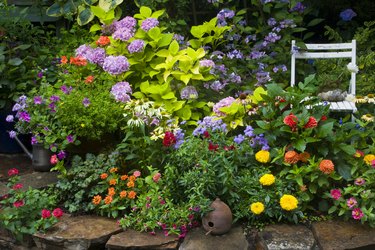
Flowers come in all shapes, sizes, and colors. The tiny flowers of sweet alyssum are half the size of a pencil eraser, while the blossoms of the tree peony are over 12 inches in diameter. Flowers grow on plants no more than a few inches high, such as lobelia, or on trees more than 30 feet tall. No matter how tiny or grand your landscape, there is always room for flowering plants.
Flowering Annual Plants
Video of the Day
Annuals are plants that grow for only one season. The seeds germinate, grow into seedlings, mature, and flower. The plant dies when the first frost comes.
Video of the Day
Most vegetables are annuals. Vegetables that flower and set fruit include peppers, squash, peas, beans, and tomatoes. Use these colorful plants in your flower garden as well as annual flowers, such as cosmos, phlox, nasturtiums, marigolds, zinnias, stock, sweet peas, and snapdragons.
Flowering Biennial Plants
Biennials are plants that grow from seed the first year and blossom and die the second year. Hollyhocks are an example. Parsley is also a biennial, better known as an herb than a flower. The flower during the second year resembles Queen Anne's lace.
Flowering Perennial Plants
Perennials live for several years or longer. They go dormant after blooming or when the first frost hits but start growing again in the spring. Some perennial flowers are tropical, such as lantana, bougainvillea, and cannas. They grow year-round in warm climates.
When planted in cold winter areas, less hardy perennials die in the fall, so they're treated as annuals and must be replanted every year. Common perennial flowers include columbine, echinacea, delphinium, foxglove, carnation, Shasta daisy and candytuft.
Bulbs, Corms, and Tubers
Bulbs, corms, and tubers are underground plant parts that act as a food-storage structure in certain seed plants. Although their are botanical differences between them — for example, true bulbs are constructed in layers while corms are solid — gardeners may refer to all of these as bulb plants. Many produce beautiful blossoms and are commonly installed in the flower garden.
Bulb plants include daffodils, iris, hyacinths, and tulips in spring, and oriental lilies, Asiatic lilies, daylilies, and amaryllis in summer. Flowering corm plants include freesias, crocus, ranunculus, and gladiolus. Begonias and bearded iris are tuber plants.
Flowering Trees and Large Shrubs
Trees that are cultivated for fruit production must flower first to form fruit. Deciduous trees that fruit and flower include apple, pear, cherry, peach, and plum. Evergreen fruit trees include lemon, lime, orange, and other citrus fruits. Some trees are planted solely for the aesthetic appeal of their flowers rather than fruit production. These include dogwood, orchid tree, and crape myrtle.
Flowering bushes include roses, of course, but also hydrangeas, forsythia, mock orange, and numerous others. Bushes may be either evergreen or deciduous. Some, like roses, are evergreen in warm-winter areas, such as California, Florida, and Arizona, but are deciduous in cold-winter areas.